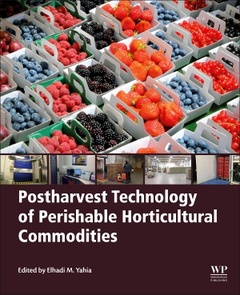Description
Postharvest Technology of Perishable Horticultural Commodities
Coordinator: Yahia Elhadi M.
Language: English
Subjects for Postharvest Technology of Perishable Horticultural...:
Keywords
Absorption refrigeration cycle; Active packaging; Aging; Agronomic practices; Biofuels; Biological and thermal valorization; Biosynthesis; Biotechnology; Biotic and abiotic stresses; Cargo; Carnot cycle; Chemical; Chilling; Cleaning; Climacteric; Climatic factors; Coefficient of performance (COP); Cold chain; Composting; Compressor; Condenser; Container; Controlled atmosphere; Controlled atmospheres; Dehumidification; Dew point; Distribution; Dry-bulb; Drying; Ethylene; Ethylene action; Evaporation; Evaporator; Flower; Food; Food safety; Food security; Forced air; Freezing; Fresh produce; Fruit; Fruits; Fruits and vegetables; Gases; Genetic factors; Grading; Harvesting equipment; Health-promoting metabolites; Heat; Heat exchanger; Horticultural commodities; Humidification; Humidity ratio; Hydrocooling; Immature; Insect control; Intelligent packaging; Ionizing energy; Manual harvest; Mature; Maturity; Mechanical harvest; Minerals; Minimal processing; Modified atmosphere; Modified atmosphere packaging; Modified atmospheres; Moisture; Nonclimacteric; Nutrition; Nutritional qualities; On-farm; Ornamentals; Packaging functions; Packaging materials; Packing house; Packing operations; Perishables; Pests; Phytosanitary; Postharvest; Postharvest losses and waste; Postharvest technology; Precooling; Properties; Psychrometrics; Quality; Quality of fruits and vegetables; Quarantine; Refrigeration; Relative humidity; Respiration; RFID; Ripening; Saturated pressure; Saturated temperature; Scavengers; Secondary fluid; Senescence; Shelf life; Shipping; Signaling; Sizing; Slurry ice; Sorting; Standard vapor compression cycle; Storage; Stress; Superheated vapor; Supply chain; Systems approach; Telematics; Temperature; Thermal expansion valve; Thermodynamic properties; Trailer; TTI; Vacuum; Value chain; Vapor; Vegetable; Vegetables; Washing; Water; Waxing; Wet-bulb<; BR>
750 p. · 19x23.3 cm · Paperback
Description
/li>Contents
/li>Readership
/li>Biography
/li>Comment
/li>
Postharvest Technology of Perishable Horticultural Commodities describes all the postharvest techniques and technologies available to handle perishable horticultural food commodities. It includes basic concepts and important new advances in the subject. Adopting a thematic style, chapters are organized by type of treatment, with sections devoted to postharvest risk factors and their amelioration. Written by experts from around the world, the book provides core insights into identifying and utilizing appropriate postharvest options for maximum results.
1. Introduction 2. Postharvest Losses and Waste 3. Classification of Horticultural Commodities 4. Preharvest Factors Affecting Postharvest Quality 5. Harvesting of Horticultural Commodities 6. Precooling 7. Refrigeration 8. Psychrometrics 9. Packing Operations 10. Minimal Processing 11. Packaging 12. Storage Systems 13. Controlled Atmosphere Storage 14. Ethylene Technology 15. Physiological Disorders and Their Control 16. Postharvest Insects and and Their Control 17. Irridiation of Fruits and Vegetables 18. Temperature-Controlled Transport for Air, Land, and Sea 19. Utilization and Management of Horticultural Waste 20. Analysis and Control Systems in Postharvest Operations 21. Biotechnology of Horticultural Commodities 22. General Recommendations
undergraduate and postgraduate students, lecturers and researchers, as well as all professionals related to the handling of horticultural food commodities.
- Presents the most recent developments in processing technologies in a single volume
- Includes a wide range of perishable products, thus allowing for translational insight
- Appropriate for students and professionals
- Written by experts as a reference resource




